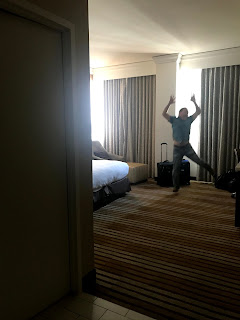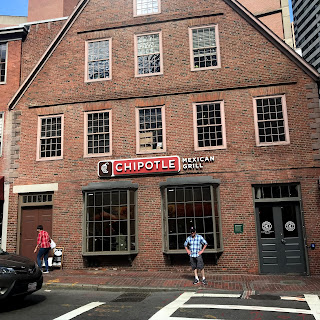In March of 2020, John and I went to West Point to visit our nephew who is a cadet there. On that trip, we also decided to visit the Baseball Hall of Fame and the FDR Presidential Library. Our first stop was to this very small town right outside the gates of the academy.
Town of Highland Falls, NY. It was established in 1906 and has a population of 3,900. The main street in the town leads up to the gate of West Point Military Academy.
Thayer Gate - West Point Military Academy.
On the main street, there were several churches quite close to one another. United Methodist Church was erected in the early 1800's as the Presbyterian Church.
Sacred Heart Catholic Church was erected in 1875.

Church of the Holy Innocents. Episcopal Church built in 1841. The church is configured so that when looking directly at the altar, you are looking in the most direct line toward Jerusalem.
The West Point Museum. This was a cool little museum that gave some of the history of West Point. It was free.
Tank outside the West Point Museum. Both are outside the gates of West Point.
If you want to get on campus, you have to get your passes.
West Point Redoubt Four. This was a strategic defensive position during the Revolutionary War due to the S-curve in the Hudson River.
Touring around the campus that first evening. The tower of the chapel was lit up and could be seen from most everywhere on campus.

View of the Hudson River at sunset.

The barracks with the lit up chapel tower behind them.

That evening the West Point Black Knights were at home and playing the Lafayette Leopards.

So we went! It was fun. It was a small stadium with open seating so we got to sit up close to the action.
The next day we got to tour the campus. West Point is the oldest continually occupied military base in the country. It is located on the banks of the Hudson River. The US has occupied the military post since 1778. It was originally known as Ft. Clinton during the Revolutionary War. It was the notorious Benedict Arnold that tried to turn the base over to the British. In 1802, it was established as the United States Military Academy. This is the parade grounds.
Campus buildings. Candidates must apply directly to the academy and must have a nomination from a member of Congress. Tuition is fully funded by the United States Army in exchange for an active duty obligation upon graduation. Most graduates are commissioned as Second Lieutenants in the Army but may also select another branch of service.
Once again, the chapel can be seen from the parade ground. The list of alumni is incredible. Almost the entire cast of generals in the Civil War attended the academy. In fact, Jefferson Davis, also an alumni, would only allow West Point grads to be Generals. There were several notable generals that came after the Civil War as well. Douglas MacArthur, John J. Pershing, Dwight D Eisenhower, just to name a few.
Inside the beautiful cadet chapel.
More of the buildings on campus. The library is to the right.
Most of the families stay at the Thayer Hotel, if they book early enough. We did not book early enough but we spent some time there. This is our cadet, Brendan Matthew Windsor.
We stayed in Newburgh, which was about 25 miles from West Point. The drive to and from was amazing. It's nothing like what you would see in Texas.
Our next venture was to Cooperstown, NY where the legendary Baseball Hall of Fame is located. Getting to Cooperstown was no easy feat. We envisioned a smaller version of Disney World. Signs everywhere, huge parking lot to take you to the museum....
Welcome to Cooperstown, NY! It was basically one main street. In order to get there, you had to go through all these small rural towns and then through some woods that were next to a big frozen lake. We really thought we were lost. The village was founded by William Cooper, father of James Fenimore Cooper way back in 1786. It's in Ostego County at the southern tip of Ostego Lake. In addition to the Baseball Hall of Fame, there is also the Fenimore Art Museum and the Farmer's Museum.
We were here for the Baseball Hall of Fame.
And this is it! We drove right past it not realizing that this was the building we were looking for. The place was deserted, which was nice in that we don't like crowds but it was odd. The experience starts with a short movie that gives a little history of baseball.
Then you go into the museum itself. In preparation for the trip, we watched the Ken Burns documentary on baseball. It's a great documentary if you haven't seen it. Lots of history. The first big exhibit is The Babe. I hadn't realized he was initially a pitcher.
There was a whole section on the Negro league. Jackie Robinson's jersey.
There really was a league of their own!
This cornerstone of Ebbets Field, the home of the Brooklyn Dodgers. It was located in Brooklyn, New York. The first game was played in 1913 against the Philadelphia Phillies. The Dodgers lost. The Dodgers left New York after the 1957 season. The field was eventually demolished in 1960.
In one exhibit, they had lockers for all the teams. John in front of the locker for his team, the Texas Rangers.
Statue of Buck O'Neil representing the Buck O'Neil Lifetime Achievement Award. He played for the Kansas City Monarchs in the Negro league. He also coached. His contributions to baseball spanned eighty years. Buck was the first recipient of the lifetime achievement award that was named for him. He died in 2006. He played a prominent part in the Ken Burns documentary.
Entering the hallowed hall of fame.
In this part of the museum, all the inductees have plaques. It is pretty awe inspiring. Lou Gehrig.
My mom's favorite, Mickey Mantle. All in all a very cool trip.
Our last adventure in New York was the Franklin Delano Roosevelt Presidential Library in Hyde Park, New York. The drive here wasn't bad.
Franklin and Eleanor greet you right outside the visitor's center.
The main attraction is the house, Springwood. FDR lived here most of his life. It was his mother's home but once he got married, he moved back in. As his family grew, he added on to the house.
A side view of the beautiful veranda and the back stairs.
The house has an amazing view of land. I imagine in the spring, this is beautiful.
John looking into the snuggery, which was used by FDR's mom. At the end of the hall was his office. FDR would wheel himself in there over rails that could be hidden (where the plexiglass is). He would then be helped into the chair behind his massive desk. The wheelchair would be put away and only then would he receive visitors.
FDR had polio. This was the elevator that took him upstairs. He would pull himself up in the elevator by pulling on the rope. He had a lot of upper body strength.
This was FDR's boyhood room.
Outside the museum. It was an amazing day.
This is the actual library/museum.
When FDR took office, the country was in the Great Depression.
The swearing in of FDR.
The New Deal created several programs that helped the US out of the depression. There were reconstructions programs for public works that created jobs. Social Security was created and banking reform was passed as well.
FDR had intended to make his office here once he left the presidency. This is the study that is part of the museum where he planned to work.
In his fourth term in office. FDR died.
FDR and Eleanor are both buried here on the grounds of Springwood.
This was an amazing trip. More so because it was right as the COVID pandemic was beginning. We had no idea how close we were to the epicenter of the breakout. We were very lucky in that we left New York without being exposed to the virus.













































































